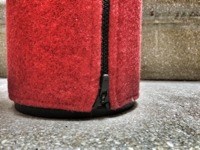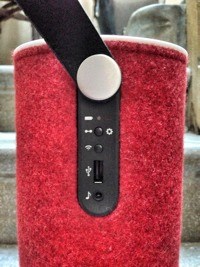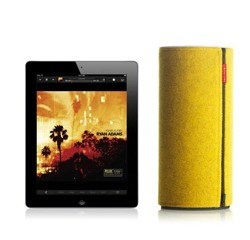Category: Airplay Speakers
Works With: iPhone, iPad, Mac
Price: $450 as tested
I thought I’d heard everything there was to hear from wireless speakers. I have tested everything from the smallest, crappiest pocket speaker to the big booming Big Jambox. Then I “hooked” the Libratone Zipp up to my iPhone, and I started to enjoy music again.
This post contains affiliate links. Cult of Mac may earn a commission when you use our links to buy items.
What It Is
The Zipp’s name comes from its zipper-fastened felt covers, available in several colors. These protect it and make it fit right into the modern, stylish home. Or the filthy hovel, I guess. It’s schtick is that it packs a Wi-Fi radio for Airplay rather than relying on Bluetooth, and this lets it use a lossless stream for wired-quality sound without the wires (you can use wires if you like – both USB and jack).
The other feature is the tunable audio. Using a companion app, you can tweak the “FullRoom Optimization” and “Voicing” settings. In English, these let you tune the sound depending on the speaker’s position, and the EQ, respectively.
The Zipp also comes with a battery inside, which lasts from four to eight hours depending on use (wired vs wireless, volume, the direction of the wind) and takes a couple of hours to charge. You can also used it powered, wherupon it also becomes a handy iPhone dock.
In Use
To use the Zipp for the first time, you switch on, plug it into your iPhone using a dock connector or Lightning cable, and let it share your Wi-Fi network settings. This is all but automatic, and needs to be done once. After that, you can just connect to the speaker using the standard AirPlay menu from any app, or from your iDevice’s app-switcher shortcut thing.

Volume can be adjusted from the iPhone or from the button on the top of the speaker, and the same button will play/pause the sound. Unlike Bluetooth speakers, which have buttons to adjust their own volume independent of the source device’s volume setting, the volume adjustment is absolute i.e. if you crank it all the way up from your iPhone, it’s all the way up. From a cold start, the Wi-Fi takes a short while to boot, and the speaker will sleep after a while if not used.
There’s a leather handle, the unit I tested came with three covers which are easy to change (with patience, anyway – you could break something if you rush), and the speaker sits upright anywhere you like. It’s very portable, but certainly not lightweight (it’s 1.8 kilos, or four pounds).
You can pipe audio in via a jack if you like (useful for extending the battery life) or you can hook up an iDevice via USB. This lets you send audio via USB, and also charges the iPhone. If you wanted, you could hook a dock up to it for easy access, but that would kind of defeat the point of its portability.
The Sound
Despite being the size of a couple of stacked coffee cans, the Zipp puts out a massive 60 watts of sound — all of them useful
This speaker sounds amazing. I have gotten so used to Bluetooth speakers and 2.1 satellite-and-sub setups that I had forgotten how good music can actually sound. Obviously I can’t compare this speaker to my memory of my old amp, CD player and floor-standing speaker setup from my days as an audio nerd, but I can compare it to the memory of how much I used to enjoy music.
Despite being the size of a couple of stacked coffee cans, the Zipp puts out a massive 60 watts of sound, all of them useful – you can jack up the volume all the way and it’s just louder, not more distorted.
Bass is big. Plenty big enough for movies as well as music. But the big surprise is the clarity. Right now I’m listening to outtakes from Billie Holiday trying to record The End of a Love Affair, and you can hear every crack of her voice, the intakes of breath and the tongue-chewing between those breaths. It’s enough to make you actually stop and listen, instead of letting it slide into the background like we do so easily with music these days.
And that’s not even a lossless file.
In short, you can crank this thing or listen to it quietly and, while it might not beat out a dedicated audiophile setup with full-sized speakers and a $1,000 amp, it’s close enough. And you can pick it up and take it with you. Try that with a pair of wired speakers – even small ones.
(Now listening to The Prodigy’s Smack My Bitch Up. Sounds fantastic).
Processing
The free Libratone app is pretty basic in terms of design, but it does the job. Better still, you can connect to the speaker from your iPhone while it streams music from your iPad or Mac (or other iPhone, I guess).
Why connect at all? Because this is where you control the sound processing.
FullRoom Voicing

This is the name Libratone gives to the fancy sound-shaping tech that lets you hear room-filling stereo sound from such a small box. Using the app, you tell the speaker where it is in the room and it will work out what sound to send in which direction, bouncing it off the walls to reach your ears at the right time.
You pick a place (floor, shelf, table, outdoor) and then tell the app how close the back wall, and the distance to the nearest side wall. The controls are somewhat desktopppy for a touchscreen app. You need to pick from a pop-up list instead of just dragging.
It works, though. I’m not sure how it sounds different, but picking the right setting certainly seems to give you better sound than the wrong one.
EQ
EQ, or what Libratone calls “Voicing” lets you tune the sound for various sources. You can pick from Neutral, Easy Listening and more, and the results are what you’d expect. I leave it in Neutral most of the time, as the setting can be a little heavy-handed. Except at movie time, that is…
Movies
The Zipp turns out to be an amazing iPad companion for movies. Stick it on a shelf, set the settings and you’re off. Airplay automatically syncs the sound
(Now listening to Talking Heads’ Psycho Killer, remastered from the version on the ‘77 album. Sweet. Tina’s bass is driving).
and pictures, just like with Bluetooth, and – unlike even the Big Jambox – the speaker has enough power to handle the annoyingly quiet soundtracks of today’s TV and movies. I have been bingeing on the original Danish The Killing over the last weeks and it sounds great. When the characters are in a car, it sounds enclosed, like they’re in a car. Dialog is clear and sound FX are punchy. Movies are the one case where I use the EQ settings, as it just seems to tighten everything up. Make sure to change it back afterwards though.
The Bad
There’s almost nothing not to like about the speaker. The app is the real problem. As well as its old-school interface, it has a comedy battery meter. This gives a percentage readout of the connected speaker, but is all over the place. Sometimes it shows 80-something percent and then the battery dies. Other times it does the opposite, or climbs up as the battery discharges. Even funnier is the little battery icon next to the percentage. Right now the meter shows 92%. The icon shows an almost empty battery, in red.
UPDATE: Libratone tells me that the percentage reading is the Wi-Fi signal strength, not the battery level. Which means that I have been getting it wrong ever since switching it on. I feel like a dummy, but it’s not for nothing: Libratone is considering updating the app to make it a little clearer for dunces like me.
There’s almost nothing not to like about the speaker. The app is the real problem
Other than that, the only barrier to buying this speaker is the price. At a minimum of $400 (the version I tested comes with three covers, and costs $450) it certainly isn’t cheap. You could probably get a decent set of speakers and an amp for that price. Then again, compared to the $300 Big Jambox, that $100 difference might seem like the best $100 you ever spent. The Big Jambox is fun and all, but the Zipp is in a different league.
Let me put it another way. If you have $300-$400 to spend on any speakers, then you should consider this, even if you weren’t planning on portable. And if you were thinking about a high-end wireless speaker, this should be on your shortlist.
Now, please excuse me. I have to see what this thing can do with some Portishead cranked up high.
 Product Name: : Libratone ZippThe Good: Sounds fantastic. The best sound from a small package I have heard. Also, the felt jackets are cute.The Bad: Not cheap. Product Name: : Libratone ZippThe Good: Sounds fantastic. The best sound from a small package I have heard. Also, the felt jackets are cute.The Bad: Not cheap.
The Verdict Will make you remember what music used to sound like. |
![The Libratone Zipp Will Make You Enjoy Music Again [Review] 1363279204.jpg](https://www.cultofmac.com/wp-content/uploads/2013/03/1363279204.jpg)

